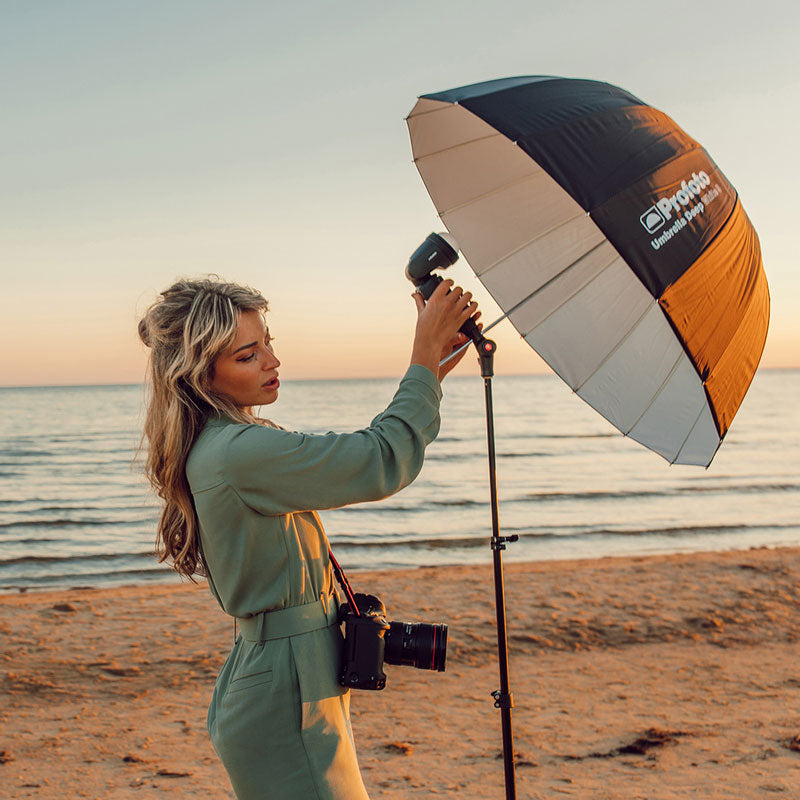As technology improves, the photography industry and how we work as a photographer evolves. If we think about it, five years ago, we wouldn’t be able to do what we can do now. Working with small lights and controlling, understanding and utilizing that light has become easier and more accessible than ever. Off-camera lighting doesn’t have to be daunting. In fact, we want to make sure you understand how easy off-camera lighting can be and how much it can improve your photography.

Light Quality vs. Light Quantity
First, understanding the difference between light quality and light quantity plays a huge role in off-camera lighting. Light quality is all about what can I do with this light? Or how can I shape this light? And light quantity is how much light is there?
Light Quality
Let’s dive into what consists of light quality. To start, it’s all about the size of any light shaping tool relative to its distance to the subject. This affects how the shadow edges and highlight details appear on the subject. As the size of any light source gets bigger, the brightness of any highlight and the sharpness of the shadow edges diminishes the same rate as the size increases. This phenomenon is called the inverse square law.

This then boils down to the importance of light shaping tools. These tools consist of beauty dishes, umbrellas and soft boxes. Each tool has its own purpose and performs an important role depending on what you are photographing.
Light Quantity
The number one question to ask yourself is “How much output is enough?” Technology has helped in this process quite a bit. Cameras nowadays have such advanced sensors that ISO sensitivity has allowed photographers to shoot in extreme low light settings with minimal grain. As a result, this makes all of the smaller lights, like flashes, more powerful. If you can go from 400 ISO to 1600 ISO, you just gained two more stops out of your light. Knowing your output and your camera’s capabilities to shoot in low light is critical.
Using Flash: the Profoto A10
There are several photographers out there who classify themselves as a “natural light photographer.” In truth, shooting only in natural light can at times be challenging. You have one main light source—the sun—and depending on the time of day, the light quality and quantity changes. With artificial light, you have the power to control both and once you’re able to find the right balance, your images will thank you for it.

When you look at exposure, 1/500th of second at F5.6 is the same exposure as 1/60th of a second at F16 because you are balancing out the stops of light. The difference in these two settings is the depth of field and motion blur controlled by the aperture and shutter speed. When you incorporate a flash into the equation, it changes everything. One simple principal to keep in mind when using a flash is expose for the place and light for the face. So, you’ll set your exposure for the ambient light. Then, all you’ll do is turn on the flash, turn on the TTL transmitter, and take the photo. The flash will then find the aperture based on what the exposure is for the location.
Shooting On Location
When shooting on location, make sure to take a battery powered light like the Profoto A10 flash or B10 strobe. These lights give you the flexibility to shoot anywhere, plus, both are small and compact so they are easy to travel with.
When it comes to knowing where to place your light when shooting outside, if the sun is located behind your subject, place your light on the opposite side. If the sun is located in front of the subject, place the light in front as well so there are no conflicting shadows. Typically, if the sun is facing the subject, most often, the subject will be squinting their eyes. A quick tip is to raise your light and soft box up to block the sun to help relieve their squinty eyes.
With the A10, most of the time, you’ll want to have it as close to the subject as possible without getting it in the shot. You gain more when you use a telephoto lens because the compression allows you to get a lot closer angle of view.
In some situations, harsh light and hot spots will be found in the background of your surroundings. If you expose for the light in the background, typically your subject will go dark. That’s when your artificial light comes int o play. You can use the flash with a soft box to create a naturally lit portrait.

Another popular setting where artificial light comes in handy would be a beach portrait with the sunset in the background. If you expose for the sun, your subject then becomes a silhouette. In order to see your subject, you need to use a flash.
If you’re a natural light photographer who might be afraid to start or you are would like to start using flash, try spending time with photographers in your local community who already know how to use one. Or watch out for lighting workshops or events on our website. Just jump in and try it! Plus, don’t be afraid to come into the store and ask questions. We’d be happy to help!

